Numerical Simulation and Field Test of a PDC Bit with Mixed Cutter Arrangement to Break Non-Homogeneous Granite
Abstract
:1. Introduction
2. Modeling and Validation of Non-Homogeneous Granites
2.1. Modeling of Non-Homogeneous Granites
2.2. Granite Model Validation
3. Construction of the Model
3.1. Simplification and Creation of 3D Models
3.2. Finite Element Model Assumptions and Evaluation Guidelines
3.3. Finite Element Modeling
4. Results and Discussion
4.1. Rock-Breaking Characteristics Analysis
4.2. Cutting Force Analysis
4.3. Mechanical Specific Energy Analysis
5. Cutter Spacing Optimization and Bit Rock Breaking Simulation
5.1. Analysis of Sampling Results
5.2. Analysis of Optimization Results
5.3. Full-Size Bit Rock Breaking Simulation
5.4. Field Applications
6. Conclusions
- (1)
- Due to the distinct shape variations between the axe, triangular prism, and cylindrical PDC cutters, the cylindrical PDC cutter predominantly crushes rocks in a shearing manner. On the other hand, the protruding ridge structure of the axe and triangular cutters exhibits a compressive effect during the rock-breaking process, thus enhancing its efficiency. The crushing effect of the axe cutter is notably more significant, raising the maximum stress on the rocks by 8.9% compared to the triangular prism cutter. This results in a stronger assault on the rocks, making it well-suited for front-row placement in drill bit cutter arrangements. Although the crushing effect of the triangular prism cutter does not match that of the axe cutter, its symmetric structure ensures stability during the cutting process, making it fit for the rear layout of the cutter. The rock-breaking performance of the cylindrical cutter is found to be the least efficient, suggesting its placement in the rear of the drill bit blade.
- (2)
- Different combinations of cutter arrangements have a significant impact on rock-breaking efficiency and stability. Therefore, it is necessary to make a rational selection of the arrangement scheme. When designing a mixed arrangement of cutters for a drill bit, it is recommended to place the axe cutters in the leading row of the blade while alternating the triangular prism and axe cutters in the rear row of the blade to fully utilize the benefits of the mixed arrangement of cutters in the drill bit.
- (3)
- The spacing between the cutters has a significant impact on the stability of the rock-breaking process. When designing a mixed arrangement of cutters for a drill bit, it is recommended to set the longitudinal distances between the leading row of axe cutters and the rear row of triangular prism cutters and axe cutters at 10 mm and 10.06 mm, respectively. The transverse distances between the centers of the rear row of triangular prism cutters and axe cutters and the centers of the leading row of axe cutters should be set at 7 mm to ensure that the mixed arrangement design maximizes drilling efficiency.
- (4)
- The numerical simulations and field drilling results indicate that compared to PDC drill bits with only axe or triangular prism cutters, the use of mixed arrangement cutter designs facilitates easier penetration of rocks, provides a more stable ROP during the rock-breaking process, and achieves higher efficiency. The utilization of PDC drill bits with mixed-arrangement cutters in complex drilling environments can effectively enhance the ROP and save drilling costs.
- (5)
- Although the numerical simulation method calculates the difference in the efficiency of the drill bit in breaking the rock in agreement with the field experiments, the calculation of the ROP of the drill bit is much different from reality. This is one of the limitations of numerical simulation of drill bit rock-breaking, but the obtained comparative simulation results are informative and can provide support for actual drilling.
Author Contributions
Funding
Conflicts of Interest
References
- Gao, D. Some research advances in well-engineering technology for unconventional hydrocarbon. Nat. Gas Ind. B 2022, 9, 41–50. [Google Scholar] [CrossRef]
- Zou, C.; Yang, Z.; He, D.; Wei, Y.; Li, J.; Jia, A.; Chen, J.; Zhao, Q.; Li, Y.; Li, J.; et al. Theory, technology, and prospects of conventional and unconventional natural gas. Pet. Explor. Dev. 2018, 45, 604–618. [Google Scholar] [CrossRef]
- Huang, H.; Zhao, B.; Wei, W.; Si, Z.; Huang, K. Effect of Cobalt Content on the Performance of Polycrystalline Diamond Compacts. Int. J. Refract. Met. Hard Mater. 2020, 92, 105312. [Google Scholar] [CrossRef]
- Shao, F.; Liu, W.; Gao, D.; Zhao, X. Development and Verification of Triple-Ridge-Shaped Cutter for PDC Bits. SPE J. 2022, 27, 3849–3863. [Google Scholar] [CrossRef]
- Cheng, Z.; Li, G.; Huang, Z.; Sheng, M.; Wu, X.; Yang, J. Analytical Modelling of Rock Cutting Force and Failure Surface in Linear Cutting Test by Single PDC Cutter. J. Pet. Sci. Eng. 2019, 177, 306–316. [Google Scholar] [CrossRef]
- Ma, Y.; Huang, Z.; Li, Q.; Zhou, Y.; Peng, S. Cutter Layout Optimization for Reduction of Lateral Force on PDC Bit Using Kriging and Particle Swarm Optimization Methods. J. Pet. Sci. Eng. 2018, 163, 359–370. [Google Scholar] [CrossRef]
- Xi, Y.; Wang, W.; Fan, L.; Zha, C.; Li, J.; Liu, G. Experimental and Numerical Investigations on Rock-Breaking Mechanism of Rotary Percussion Drilling with a Single PDC Cutter. J. Pet. Sci. Eng. 2022, 208, 109227. [Google Scholar] [CrossRef]
- Zhang, Z.; Zhao, D.; Zhao, Y.; Gao, K.; Zhang, C.; Lü, X. 3D Numerical Simulation Study of Rock Breaking of the Wavy PDC Cutter and Field Verification. J. Pet. Sci. Eng. 2021, 203, 108578. [Google Scholar] [CrossRef]
- Dong, Z.; Zhang, H.; Li, J.; Zhang, K.; Ou, Y.; Lu, Z.; Shi, J. A Method for Evaluating the Rock Breaking Efficiency of Cutters and Optimizing the PDC Cutter Profile—A Study of Igneous Rock Formations in Shunbei Oilfield. Energies 2022, 15, 6686. [Google Scholar] [CrossRef]
- Xiong, C.; Huang, Z.; Yang, R.; Sheng, M.; Shi, H.; Dai, X.; Wu, X.; Zhang, S. Comparative Analysis Cutting Characteristics of Stinger PDC Cutter and Conventional PDC Cutter. J. Pet. Sci. Eng. 2020, 189, 106792. [Google Scholar] [CrossRef]
- Ayop, A.Z.; Bahruddin, A.Z.; Maulianda, B.; Prakasan, A.; Dovletov, S.; Atdayev, E.; Rani, A.M.A.; Elraies, K.A.; Ganat, T.A.; Barati, R.; et al. Numerical Modeling on Drilling Fluid and Cutter Design Effect on Drilling Bit Cutter Thermal Wear and Breakdown. J. Pet. Explor. Prod. Technol. 2020, 10, 959–968. [Google Scholar] [CrossRef] [Green Version]
- Li, S.; Zhu, X.; Liang, K.; Deng, Y.; Liu, H. Numerical Simulation Study on Optimizing the Conical Cutter Bit to Break Deep Strata. Recent Pat. Eng. 2023, 18, 108578. [Google Scholar] [CrossRef]
- Crane, D.; Zhang, Y.; Douglas, C.; Song, H.; Gan, X.; Lin, Z.; Mueller, L.; Skoff, G.; Self, J.; Krough, B. Innovative PDC Cutter with Elongated Ridge Combines Shear and Crush Action to Improve PDC Bit Performance. In Proceedings of the SPE Middle East Oil & Gas Show and Conference, Manama, Kingdom of Bahrain, 6–9 March 2017; SPE: Manama, Kingdom of Bahrain, 2017; p. D031S014R004. [Google Scholar]
- Shao, F.; Liu, W.; Gao, D.; Ye, Y. Study on Rock-Breaking Mechanism of Axe-Shaped PDC Cutter. J. Pet. Sci. Eng. 2021, 205, 108922. [Google Scholar] [CrossRef]
- Yoan Mardiana, R.; Pasaribu, S. The Effects of PDC Cutter Geometries to the Drilling Dynamics in Various Geothermal Rocks: A Comprehensive Study Using Advanced Drilling Dynamics Simulation. IOP Conf. Ser. Earth Environ. Sci. 2022, 1014, 012006. [Google Scholar] [CrossRef]
- Kunshin, A.A.; Buslaev, G.V.; Reich, M.; Ulyanov, D.S.; Sidorkin, D.I. Numerical Simulation of Nonlinear Processes in the “Thruster—Downhole Motor—Bit” System While Extended Reach Well Drilling. Energies 2023, 16, 3759. [Google Scholar] [CrossRef]
- Wang, C.; Li, S.; Zhang, L. Evaluation of Rock Abrasiveness Class Based on the Wear Mechanisms of PDC Cutters. J. Pet. Sci. Eng. 2019, 174, 959–967. [Google Scholar] [CrossRef]
- Zeng, Y.; He, W.; Zhang, Z.; Shi, H.; Zhou, J.; Ding, S.; Ma, G. Rock-Breaking Performances of Innovative Triangular-Shaped Polycrystalline Diamond Compact Cutter. Rev. Sci. Instrum. 2021, 92, 035115. [Google Scholar] [CrossRef]
- Liu, J.; Zheng, H.; Kuang, Y.; Xie, H.; Qin, C. 3D Numerical Simulation of Rock Cutting of an Innovative Non-Planar Face PDC Cutter and Experimental Verification. Appl. Sci. 2019, 9, 4372. [Google Scholar] [CrossRef] [Green Version]
- Chen, C.; Yan, J.; Zou, Y.; Luo, H. Geometric Evolvement, Simulation, and Test of a Bionic Lateral PDC Reamer Bit Inspired by Capra Sibirica Horn. Appl. Bionics Biomech. 2022, 2022, 1–11. [Google Scholar] [CrossRef]
- Huang, Z.; Xie, D.; Xie, B.; Zhang, W.; Zhang, F.; He, L. Investigation of PDC Bit Failure Base on Stick-Slip Vibration Analysis of Drilling String System plus Drill Bit. J. Sound Vib. 2018, 417, 97–109. [Google Scholar] [CrossRef]
- Tian, K.; Detournay, E. Influence of PDC Bit Cutter Layout on Stick–Slip Vibrations of Deep Drilling Systems. J. Pet. Sci. Eng. 2021, 206, 109005. [Google Scholar] [CrossRef]
- Wang, Y.; Ni, H.; Wang, R.; Huang, B.; Liu, S.; Zhang, H. Numerical Simulation Research on Cutting Rock with a PDC Cutter Assisted by an Impact Force. Adv. Civ. Eng. 2022, 2022, 1–9. [Google Scholar] [CrossRef]
- Shao, F.; Liu, W.; Gao, D. Effects of the Chamfer and Materials on Performance of PDC Cutters. J. Pet. Sci. Eng. 2021, 205, 108887. [Google Scholar] [CrossRef]
- Zhu, X.; Dan, Z. Numerical Simulation of Rock Breaking by PDC Bit in Hot Dry Rocks. Nat. Gas Ind. B 2019, 6, 619–628. [Google Scholar] [CrossRef]
- Jamaludin, A.A.; Mehat, N.M.; Kamaruddin, S. Investigating the Effects of PDC Cutters Geometry on ROP Using the Taguchi Technique. J. Phys. Conf. Ser. 2017, 908, 012041. [Google Scholar] [CrossRef]
- Lam, K.Y.; Nélieu, S.; Benoit, P.; Passeport, E. Optimizing Constructed Wetlands for Safe Removal of Triclosan: A Box–Behnken Approach. Environ. Sci. Technol. 2020, 54, 225–234. [Google Scholar] [CrossRef]
- Silva, T.P.; Ferreira, A.N.; De Albuquerque, F.S.; De Almeida Barros, A.C.; Da Luz, J.M.R.; Gomes, F.S.; Pereira, H.J.V. Box–Behnken Experimental Design for the Optimization of Enzymatic Saccharification of Wheat Bran. Biomass Convers. Biorefinery 2022, 12, 5597–5604. [Google Scholar] [CrossRef]
- Angel, R.J.; Alvaro, M.; Nestola, F. 40 Years of Mineral Elasticity: A Critical Review and a New Parameterisation of Equations of State for Mantle Olivines and Diamond Inclusions. Phys. Chem. Miner. 2018, 45, 95–113. [Google Scholar] [CrossRef]
- Zhang, Y.; Wong, L.N.Y.; Chan, K.K. An Extended Grain-Based Model Accounting for Microstructures in Rock Deformation. J. Geophys. Res. Solid Earth 2019, 124, 125–148. [Google Scholar] [CrossRef]
- Peng, J.; Wong, L.N.Y.; Teh, C.I.; Li, Z. Modeling Micro-Cracking Behavior of Bukit Timah Granite Using Grain-Based Model. Rock Mech. Rock Eng. 2018, 51, 135–154. [Google Scholar] [CrossRef]
- Wang, L.; Bo, L.; Feng, L. Mechanical properties of heterogeneous rock under uniaxial compression based on mineral crystal model. Chin. J. Geotech. Eng. 2020, 42, 542–550. (In Chinese) [Google Scholar] [CrossRef]
- Zhang, Z.; Zhao, D.; Zhao, Y.; Zhou, Y.; Tang, Q.; Han, J. Simulation and Experimental Study on Temperature and Stress Field of Full-Sized PDC Bits in Rock Breaking Process. J. Pet. Sci. Eng. 2020, 186, 106679. [Google Scholar] [CrossRef]
- El-Sheikh, S.M.; Barhoum, A.; El-Sherbiny, S.; Morsy, F.; El-Midany, A.A.-H.; Rahier, H. Preparation of Superhydrophobic Nanocalcite Crystals Using Box–Behnken Design. Arab. J. Chem. 2019, 12, 1479–1486. [Google Scholar] [CrossRef] [Green Version]
- Xie, H.; Kuang, Y.; Qin, C. Finite element simulation and test of rock breaking by non-planar PDC cutters. J. Pet. Drill. Tech. 2019, 47, 69–73. [Google Scholar] [CrossRef]
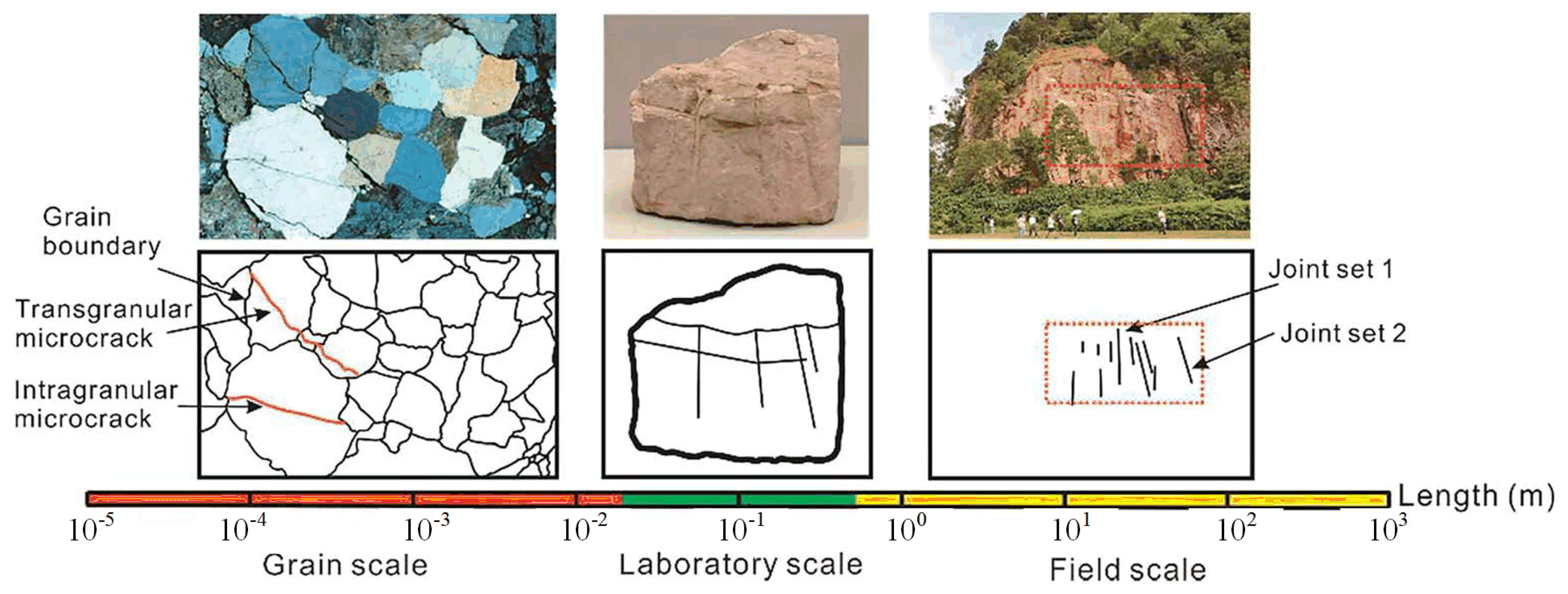
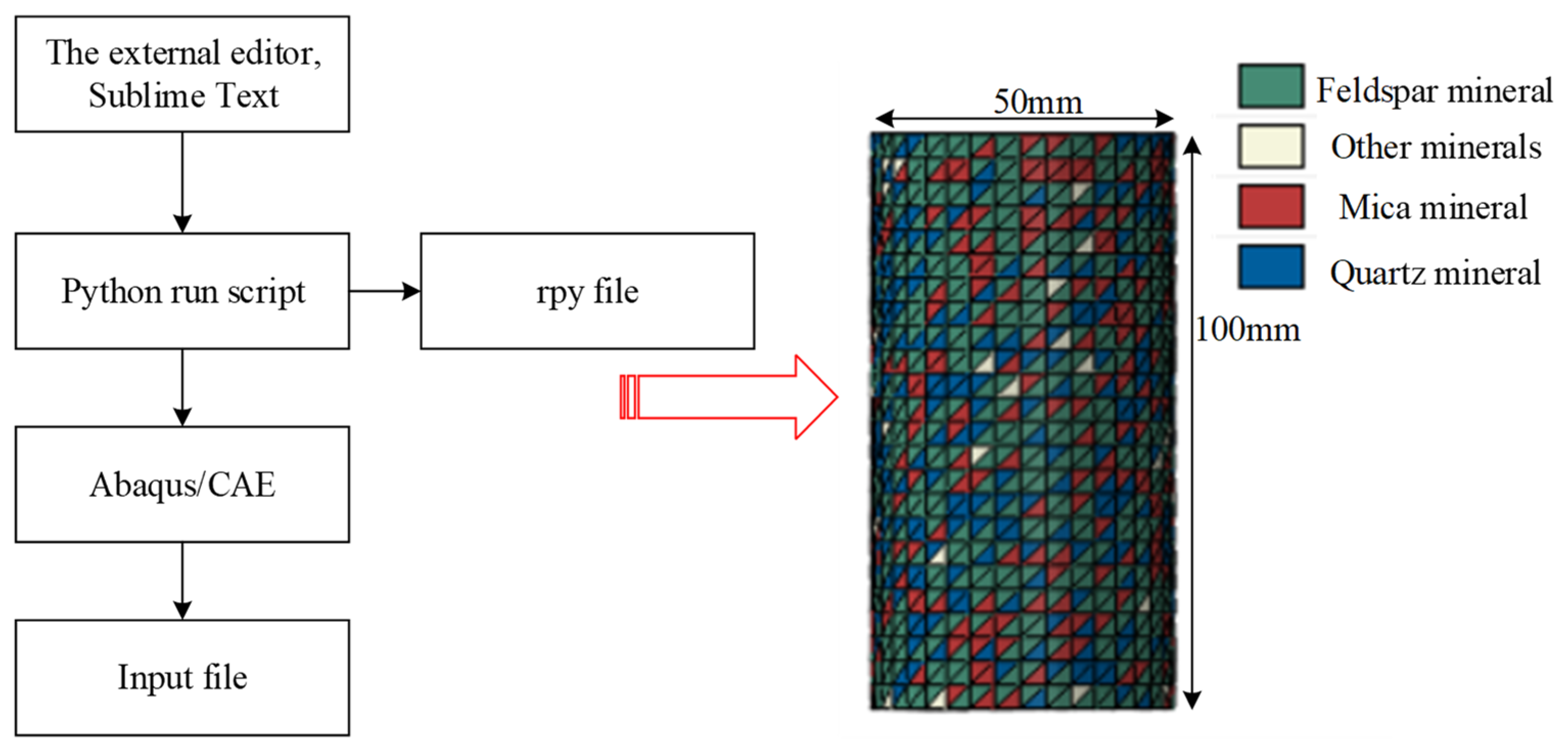


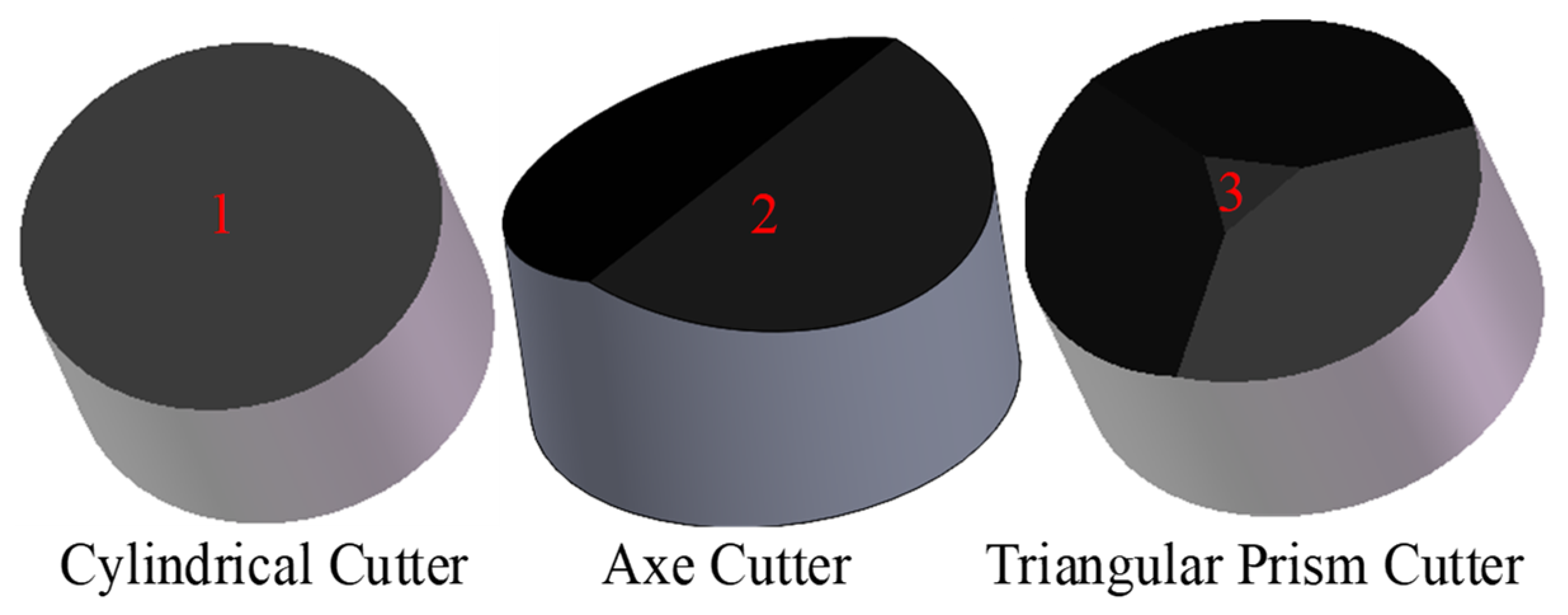
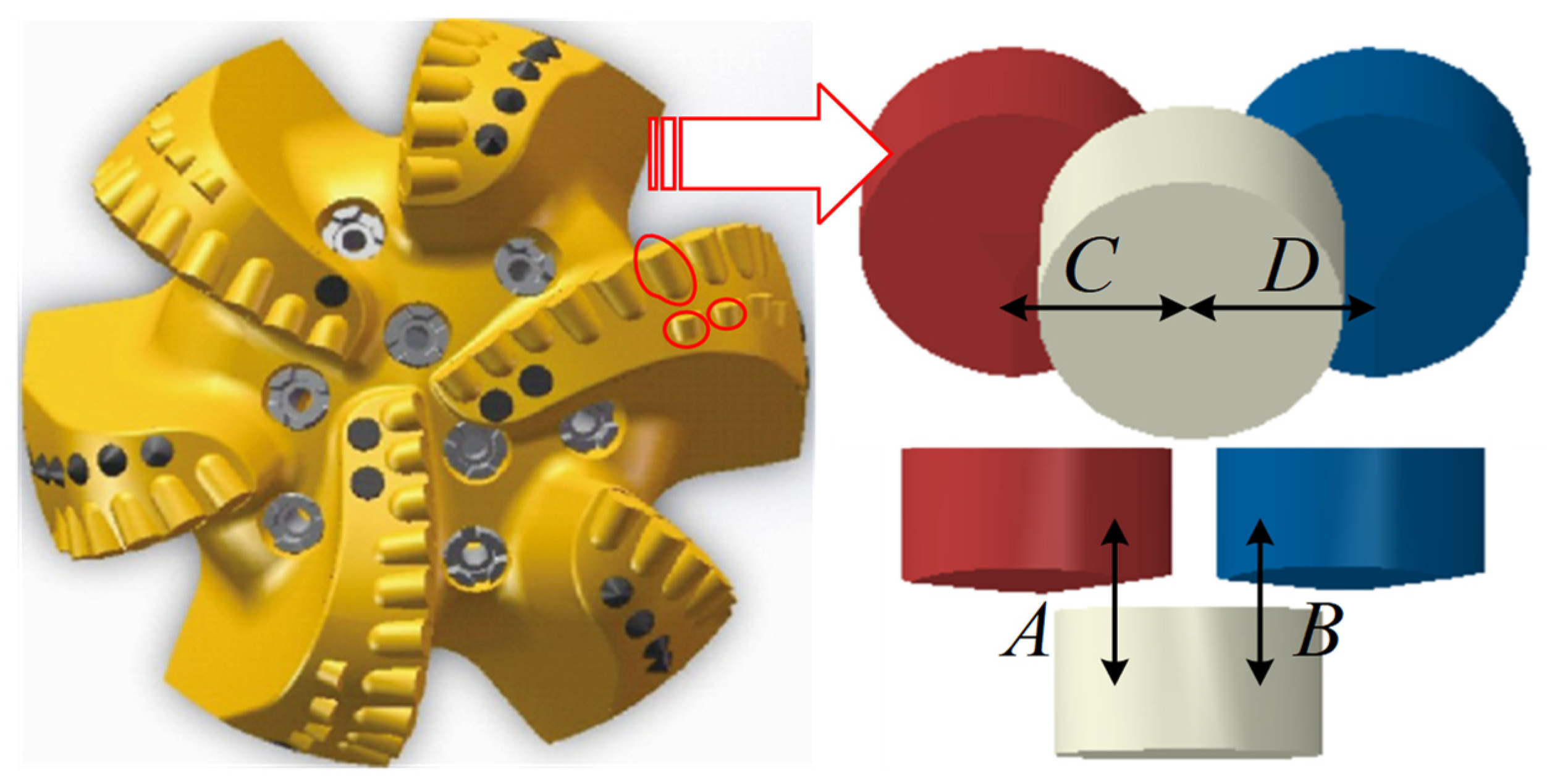

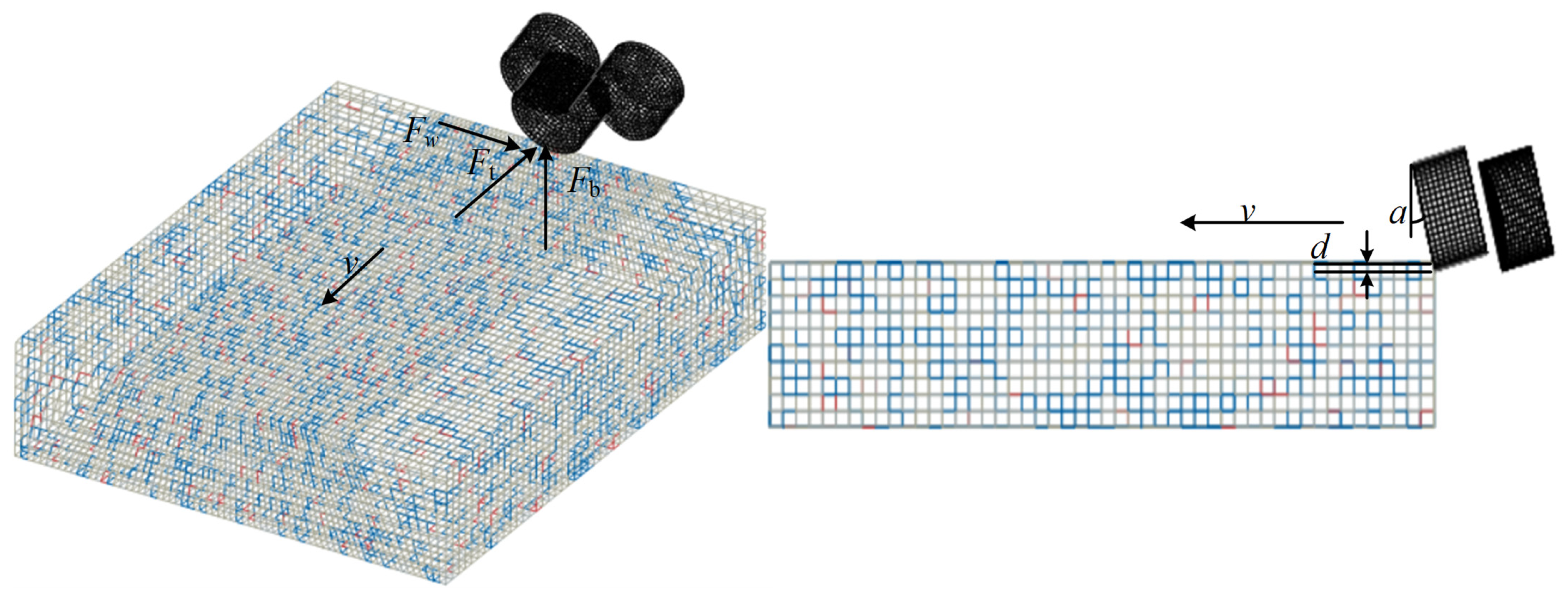

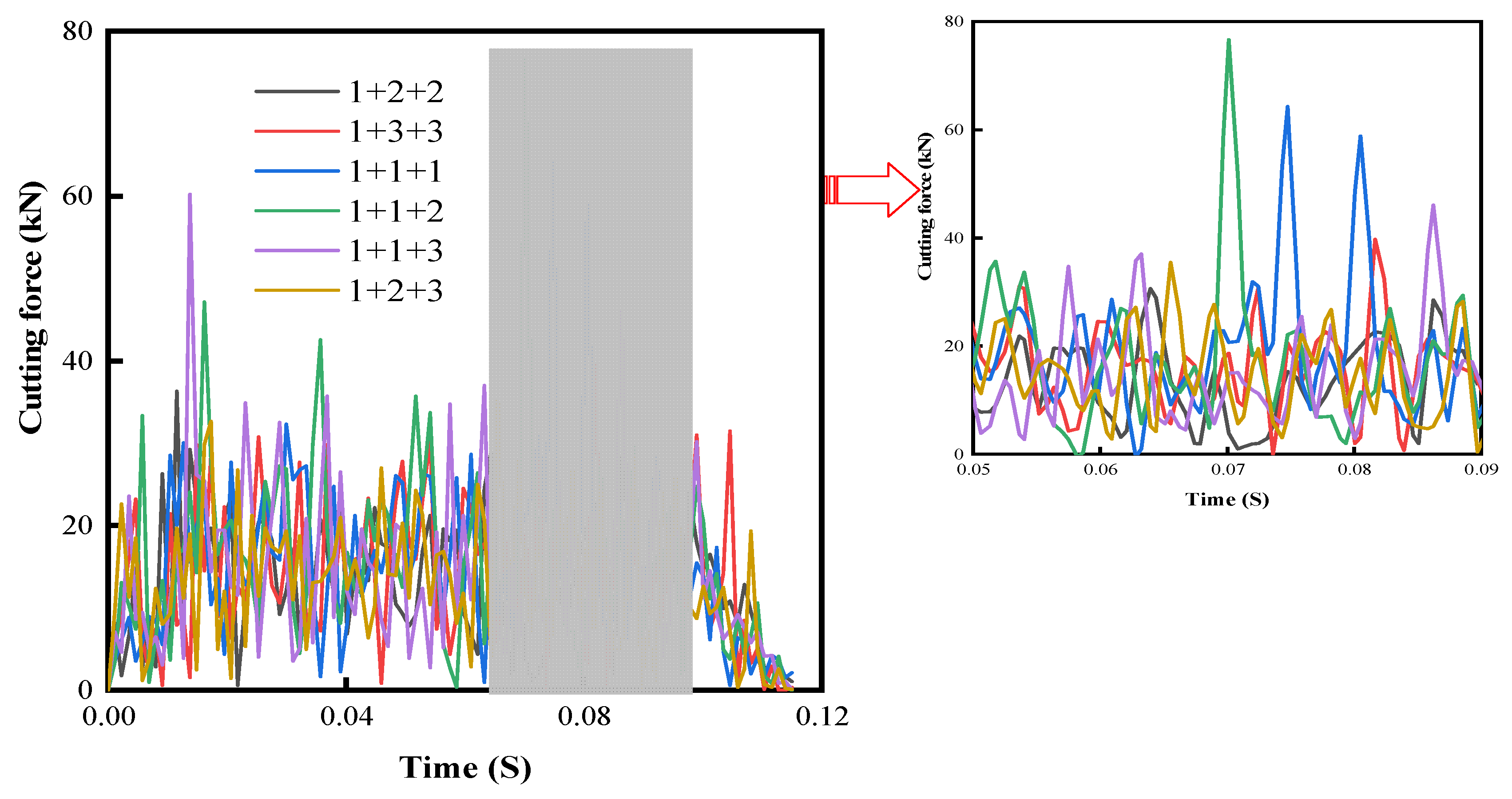

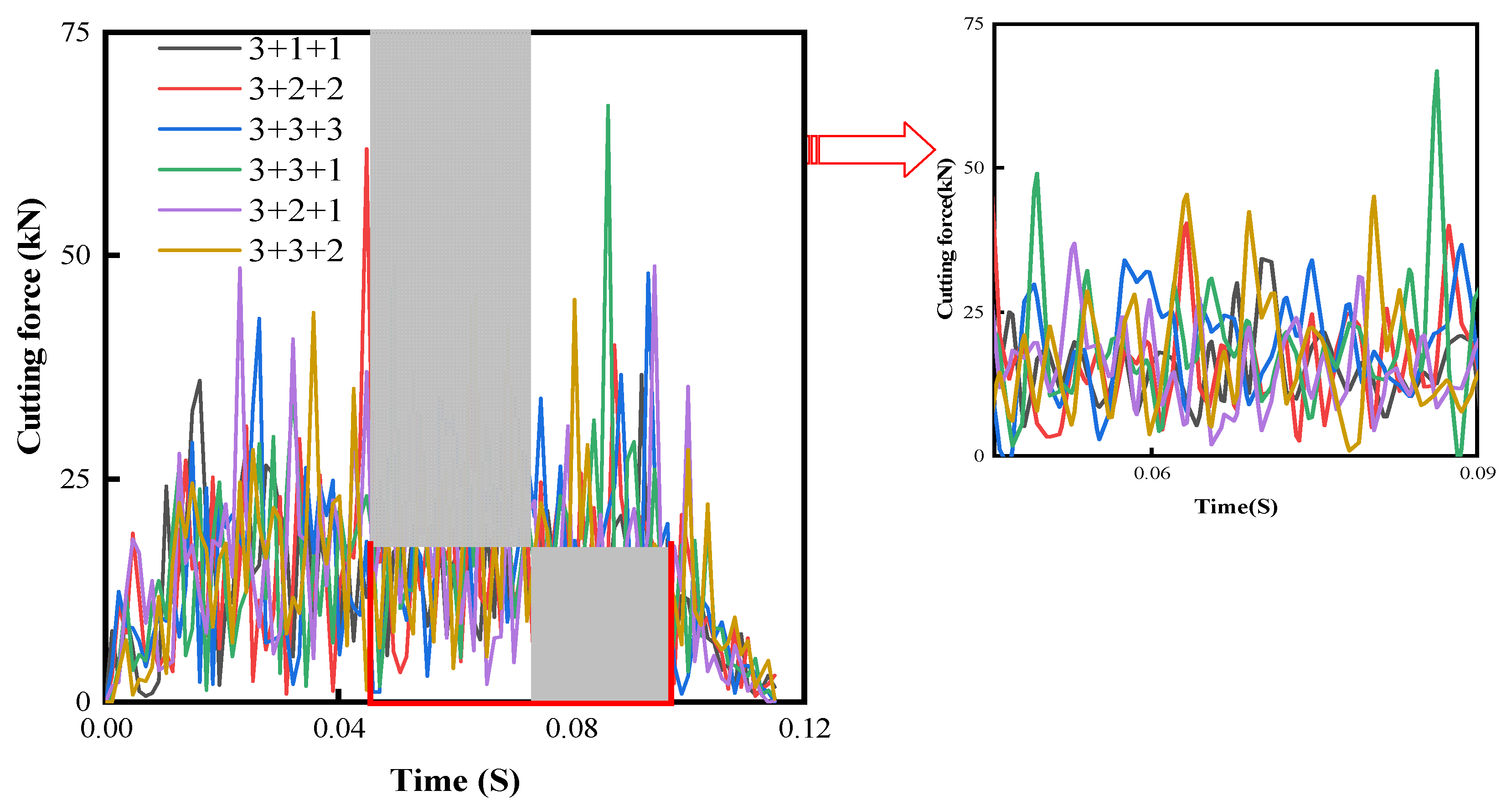
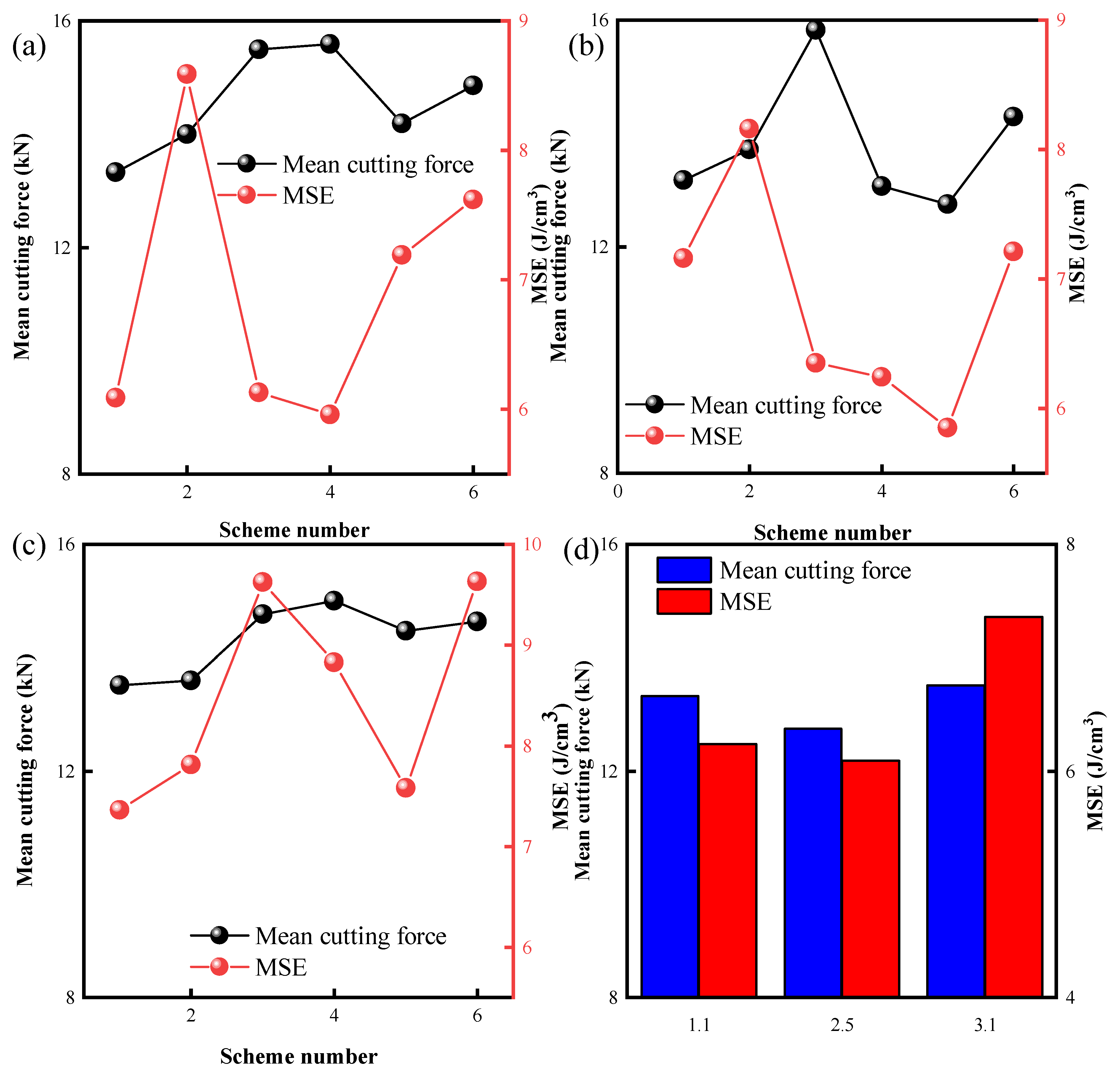

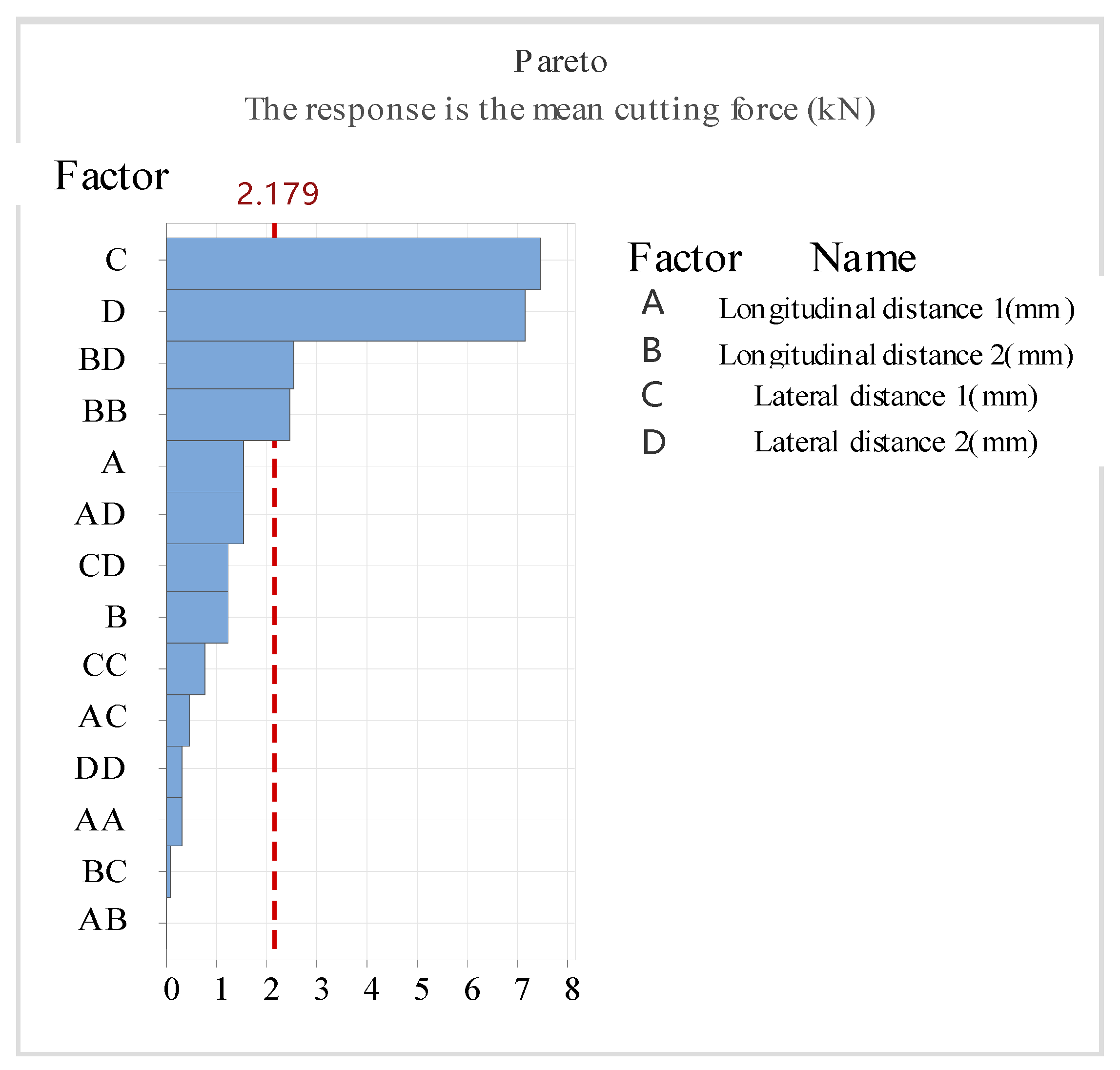


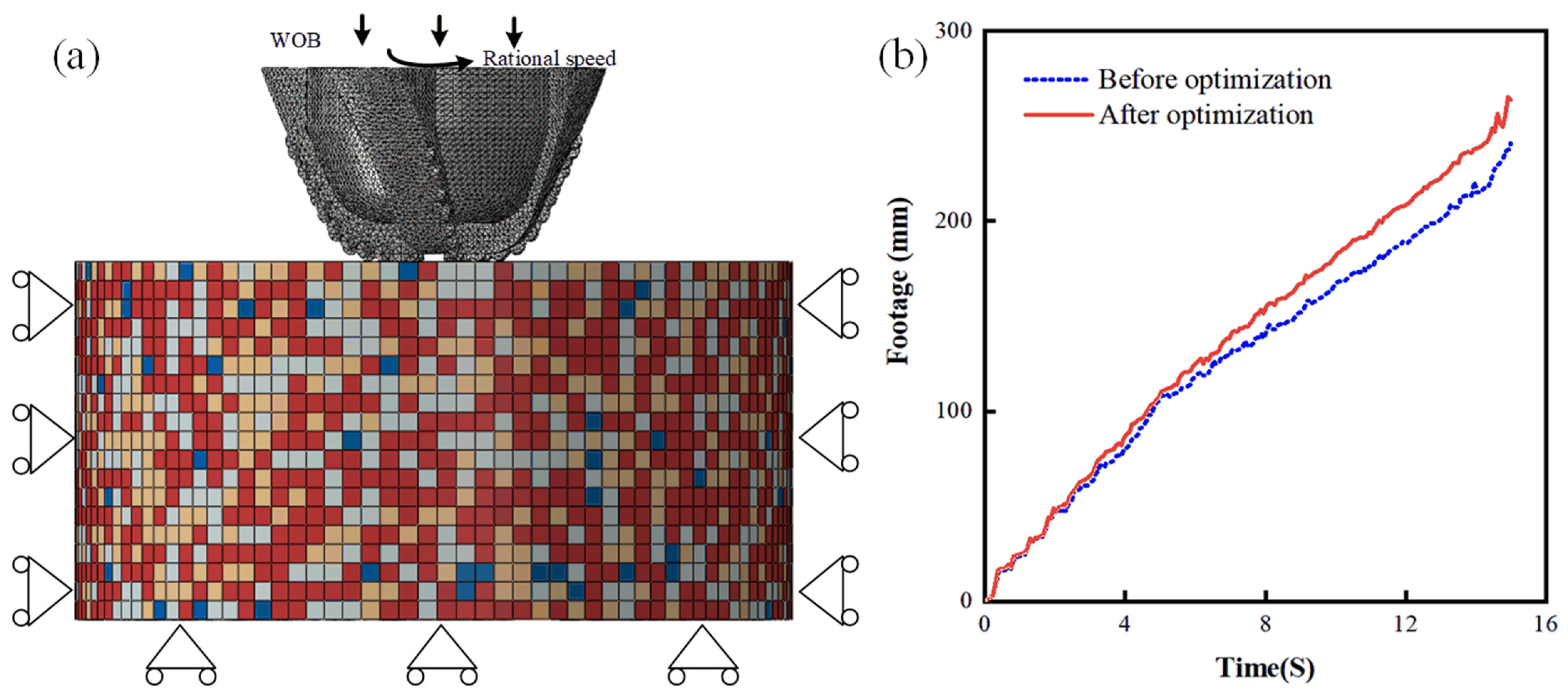

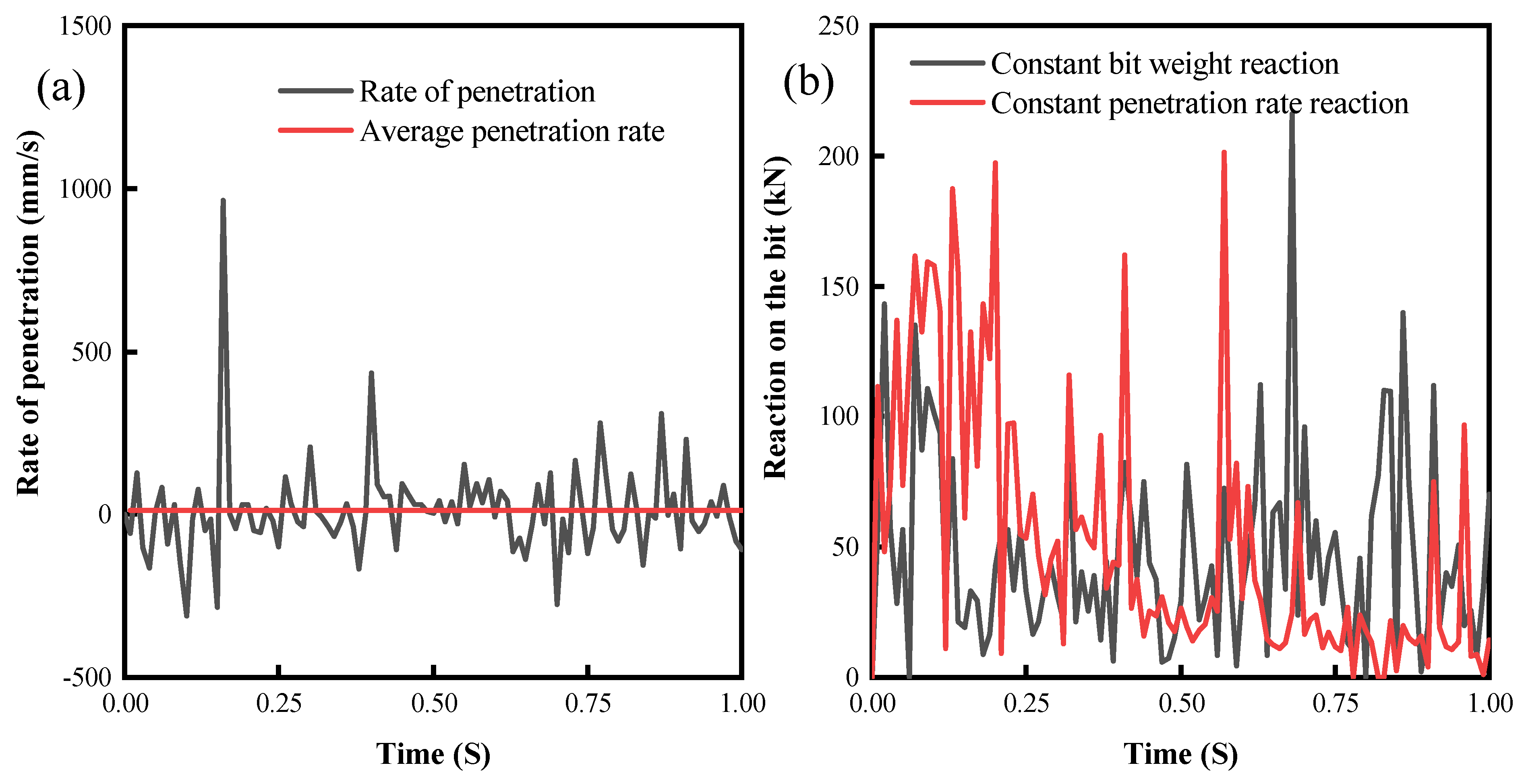
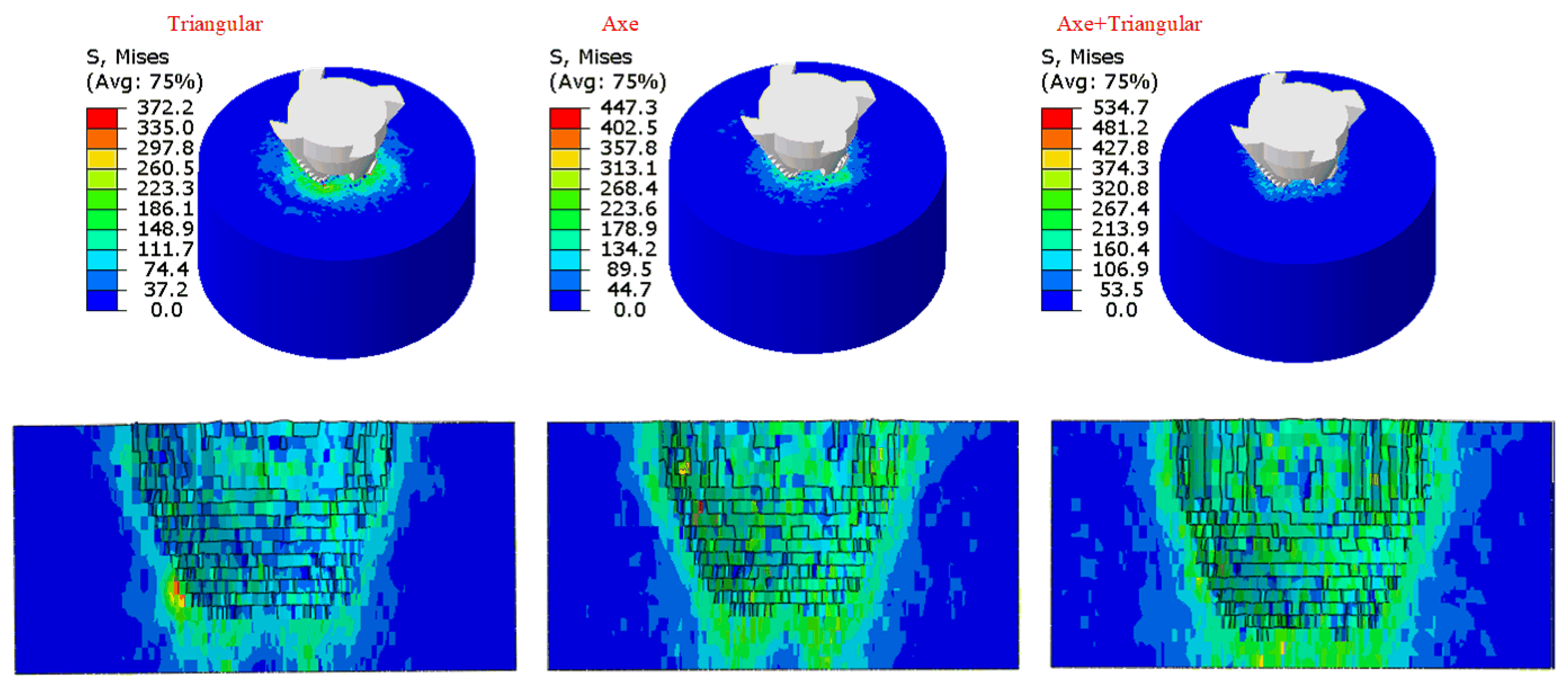

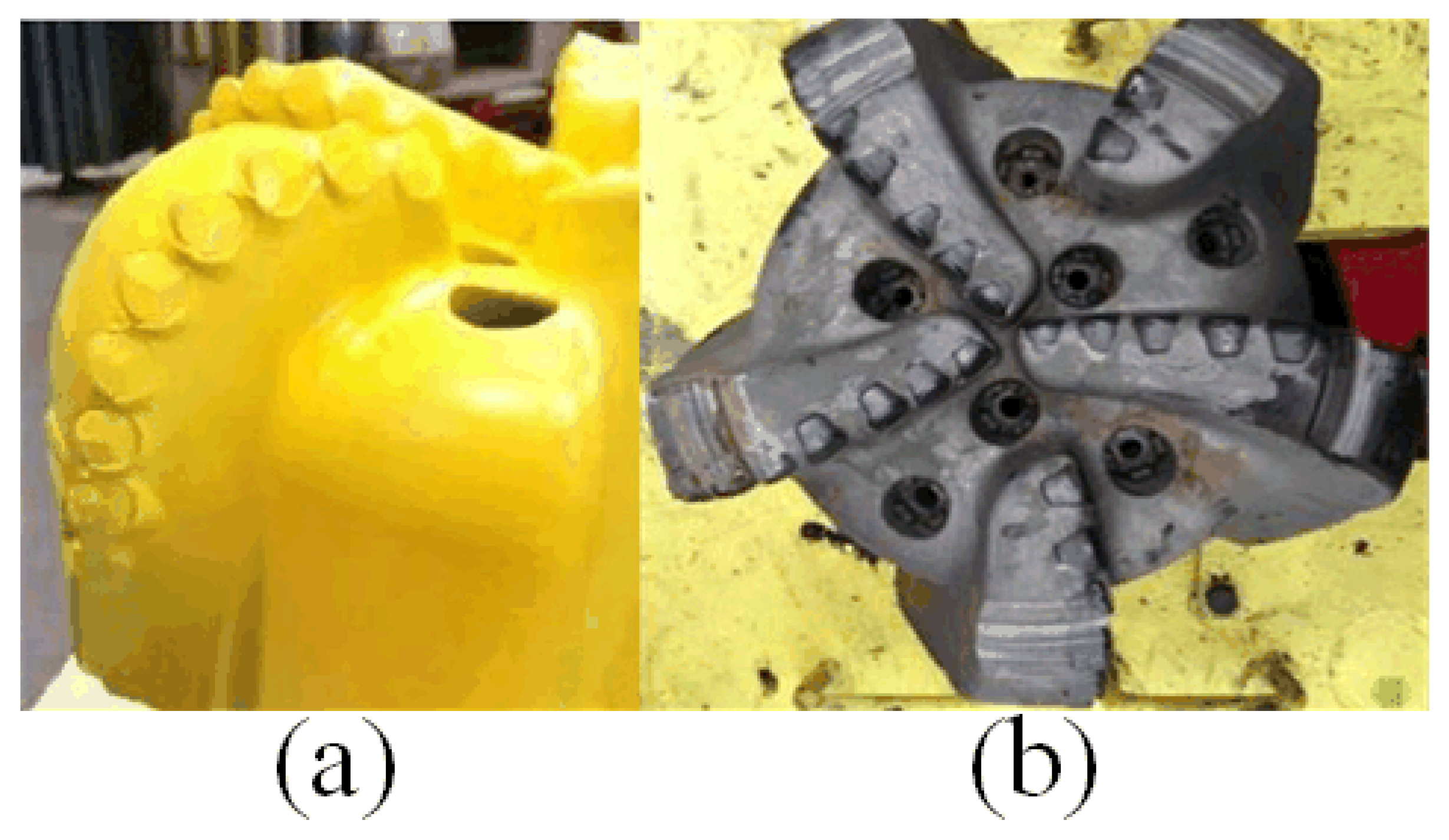

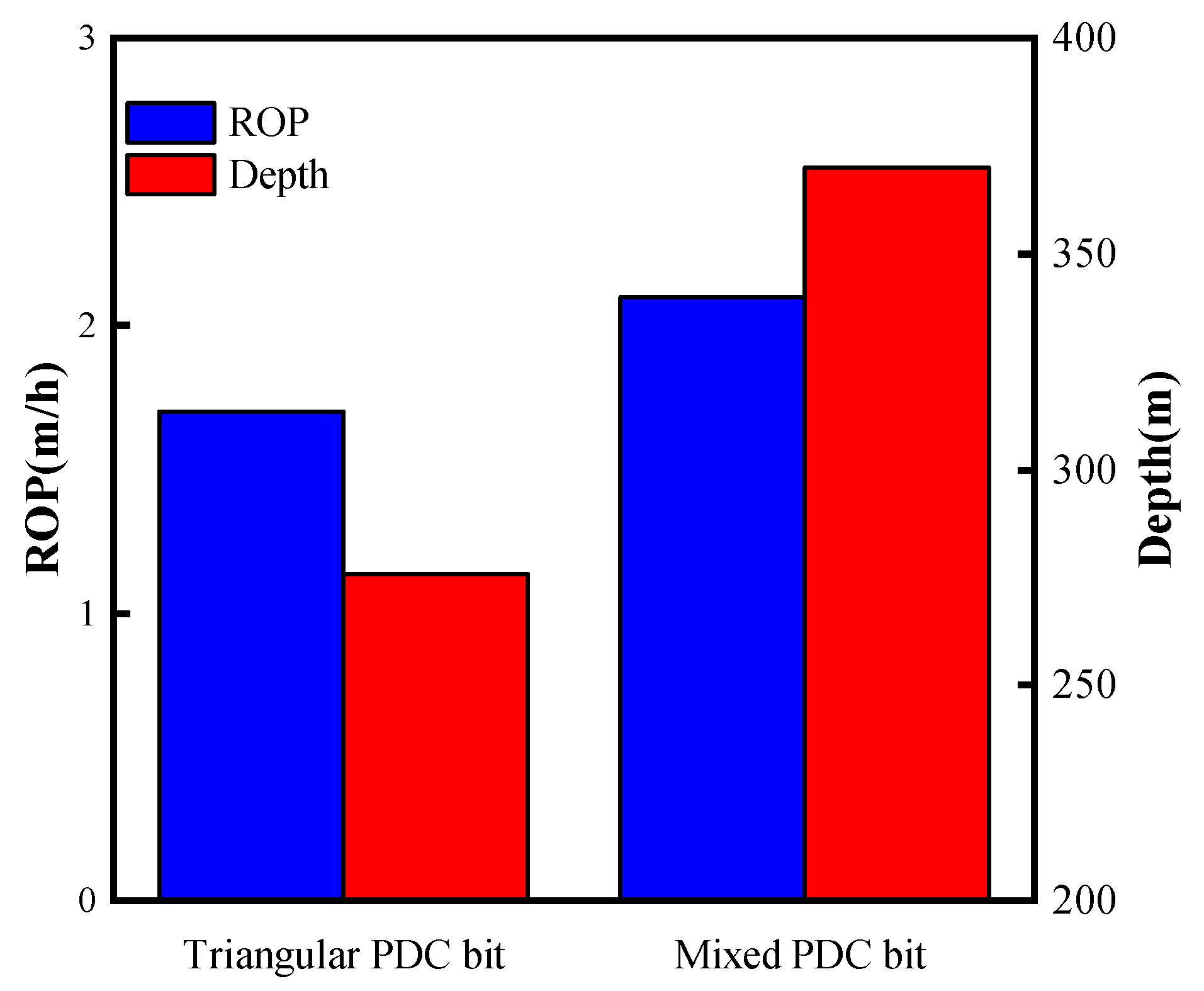
| Parameters | Quartz Mineral | Feldspar Mineral | Mica Mineral | Other Mineral |
|---|---|---|---|---|
| Volume content/(%) | 24 | 49 | 24 | 3 |
| Density/(kg/m3) | 2650 | 2600 | 3050 | 1650 |
| Elastic/(GPa) | 51 | 42 | 33 | 24 |
| Linear stiffness ratio | 1.1 | 1.3 | 1.7 | 3.7 |
| Parallel modulus of elasticity | 51 | 42 | 33 | 24 |
| Bonding stiffness ratio | 1.1 | 1.3 | 1.7 | 3.7 |
| Tensile strength/(MPa) | 126 ± 16 | 105 ± 16 | 98 ± 13 | 77 ± 9 |
| Bonding strength/(MPa) | 196 ± 42 | 162 ± 28 | 146 ± 22 | 105 ± 0 |
| Friction angle/(°) | 19.5 | 22.4 | 17.3 | 23.7 |
| Serial Number | Factors | Cutting Force Average Value E/kN | |||
|---|---|---|---|---|---|
| A/mm | B/mm | C/mm | D/mm | ||
| 1 | 15.0 | 12.5 | 12.0 | 9.5 | 16.7153 |
| 2 | 12.5 | 15.0 | 7.0 | 9.5 | 14.4970 |
| 3 | 12.5 | 12.5 | 12.0 | 12.0 | 18.6900 |
| 4 | 15.0 | 12.5 | 9.5 | 12.0 | 15.7510 |
| 5 | 10.0 | 10.0 | 9.5 | 9.5 | 14.5990 |
| 6 | 12.5 | 12.5 | 9.5 | 9.5 | 15.1812 |
| 7 | 15.0 | 12.5 | 9.5 | 7.0 | 14.7283 |
| 8 | 10.0 | 12.5 | 12.0 | 9.5 | 16.0326 |
| 9 | 15.0 | 12.5 | 7.0 | 9.5 | 14.6482 |
| 10 | 10.0 | 12.5 | 9.5 | 7.0 | 13.7766 |
| 11 | 15.0 | 10.0 | 9.5 | 9.5 | 15.4635 |
| 12 | 12.5 | 10.0 | 7.0 | 9.5 | 14.6482 |
| 13 | 12.5 | 12.5 | 9.5 | 9.5 | 15.1812 |
| 14 | 10.0 | 12.5 | 7.0 | 9.5 | 14.2570 |
| 15 | 12.5 | 12.5 | 7.0 | 7.0 | 13.2620 |
| 16 | 12.5 | 12.5 | 9.5 | 9.5 | 15.1812 |
| 17 | 12.5 | 15.0 | 12.0 | 9.5 | 18.2124 |
| Bit Type | Minimum Value of ROP/mm·s−1 | Maximum Value of ROP/mm·s−1 | ROP Variance | ROP Standard Deviation |
|---|---|---|---|---|
| Bit with an axe cutter | −52.87 | 69.24 | 388.11 | 19.7 |
| Bit with a triangular cutter | −38.39 | 55.15 | 258.09 | 16.06 |
| Bit with a mixed set of cutters | −19.95 | 26.77 | 83.59 | 9.14 |
Disclaimer/Publisher’s Note: The statements, opinions and data contained in all publications are solely those of the individual author(s) and contributor(s) and not of MDPI and/or the editor(s). MDPI and/or the editor(s) disclaim responsibility for any injury to people or property resulting from any ideas, methods, instructions or products referred to in the content. |
© 2023 by the authors. Licensee MDPI, Basel, Switzerland. This article is an open access article distributed under the terms and conditions of the Creative Commons Attribution (CC BY) license (https://creativecommons.org/licenses/by/4.0/).
Share and Cite
Wu, Z.; Yuan, R.; Zhang, W.; Hu, S.; Jiang, W. Numerical Simulation and Field Test of a PDC Bit with Mixed Cutter Arrangement to Break Non-Homogeneous Granite. Appl. Sci. 2023, 13, 9133. https://doi.org/10.3390/app13169133
Wu Z, Yuan R, Zhang W, Hu S, Jiang W. Numerical Simulation and Field Test of a PDC Bit with Mixed Cutter Arrangement to Break Non-Homogeneous Granite. Applied Sciences. 2023; 13(16):9133. https://doi.org/10.3390/app13169133
Chicago/Turabian StyleWu, Zebing, Ruofei Yuan, Wenxi Zhang, Shiyao Hu, and Wen Jiang. 2023. "Numerical Simulation and Field Test of a PDC Bit with Mixed Cutter Arrangement to Break Non-Homogeneous Granite" Applied Sciences 13, no. 16: 9133. https://doi.org/10.3390/app13169133
APA StyleWu, Z., Yuan, R., Zhang, W., Hu, S., & Jiang, W. (2023). Numerical Simulation and Field Test of a PDC Bit with Mixed Cutter Arrangement to Break Non-Homogeneous Granite. Applied Sciences, 13(16), 9133. https://doi.org/10.3390/app13169133






